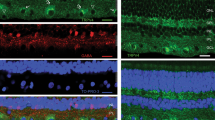Abstract
γ-AMINOBUTYRIC acid (GABA) is the main inhibitory neurotransmitter in the central nervous system. Two classes of GABA receptors (GABAA and GABAB) have been identified. GABAA receptors are ligandgated chloride channels that are competitively antagonized by bicuculline, noncompetitively blocked by picrotoxin, and often allosterically modulated by barbiturates and benzodiazepines1–3. GABAB receptors regulate potassium and calcium channels through G-protein and intra-cellular second-messenger pathways2,3, are selectively activated by baclofen, and are antagonized by phaclofen and 2-hydroxysaclofen4,5. For some years, evidence has accumulated that there are GABA receptors, especially prominent along visual pathways, which are neither antagonized by bicuculline nor activated by baclofen, but are activated by certain conformationally restricted analogues of GABA, including cis-4-aminocrotonic acid (CACA)6–9. These receptors have been designated GABAC receptors9. As yet, membrane current responses from isolated neurons that reflect this novel pharmacology have not been reported, although such responses have been recorded from oocytes injected with retinal messenger RNA10–13. Here we describe a chloridemediated current response from isolated rod-driven horizontal cells (H4) of the white perch retina that has this novel pharmacology.
This is a preview of subscription content, access via your institution
Access options
Subscribe to this journal
Receive 51 print issues and online access
$199.00 per year
only $3.90 per issue
Buy this article
- Purchase on Springer Link
- Instant access to full article PDF
Prices may be subject to local taxes which are calculated during checkout
Similar content being viewed by others
References
Olsen, R. W. A. Rev. Pharmac. Toxicol. 22, 245–277 (1982).
Bormann, J. Trends Neurosci. 11, 112–116 (1988).
Sivilotti, L. & Nistri, A. Prog. Neurobiol. 36, 35–92 (1991).
Hill, D. R. & Bowery, N. G. Nature 290, 149–152 (1981).
Kerr, D. I. B., Ong, J., Johnston, G. A. R., Abbenante, J. & Prager, R. H. Neurosci. Lett. 92, 92–96 (1988).
Johnston, G. A. R. et al. J. Neurochem. 24, 157–160 (1975).
Drew, C. A., Johnston, G. A. R. & Weatherby, R. P. Neurosci. Lett 52, 317–321 (1984).
Sivilotti, I. & Nistri, A. Eur. J. Pharmac. 164, 205–212 (1989).
Johnston, G. A. R. in Benzodiazepine/GABA Receptors and Chloride Channels. Receptor Biochemistry and Methodology (eds Olsen, R. W. & Venter, J. C.) Vol. 5, 57–71 (Liss, New York, 1986).
Polenzani, L., Woodward, R. M. & Miledi, R. Proc. natn. Acad. Sci. U.S.A. 88, 4318–4322 (1991).
Woodward, R. M., Polenzani, L. & Miledi, R. Molec. Pharmac. 42, 165–173 (1992).
Cutting, G. R. et al. Proc. natn. Acad. Sci. U.S.A. 88, 2673–2677 (1991).
Shimada, S., Cutting, G. & Uhl, G. R. Molec. Pharmac. 41, 683–687 (1992).
Gallagher, J. P., Higashi, H. & Nishi, S. J. Physiol., Lond. 275, 263–282 (1978).
Akaike, N., Hattori, K., Inomata, N. & Oomura, Y. J. Physiol., Lond. 360, 367–386 (1985).
Houamed, K. M. et al. Nature 310, 318–321 (1984).
Itabashi, S., Aibara, K., Sasaki, H. & Akaike, N. J. Neurophysiol. 67, 1367–1374 (1992).
Mathison, R. D. & Dreifuss, J. J. Brain Res. 187, 476–480 (1980).
Curtis, D. R., Bornstein, J. C. & Lodge, D. Brain Res. 194, 255–258 (1980).
Nakagawa, T., Wakamori, M., Shirasaki, T. Nakaye, T. & Akaike, N. Am. J. Physiol. 260, c745–c749 (1991).
Arakawa, T. & Okada, Y. Eur. J. Pharmac. 158, 217–224 (1988).
Olsen, R. W. & Tobin, A. J. FASEB J. 4, 1469–1480 (1990).
Seeburg, P. H. et al. Cold Spring Harbor Symp. quant. Biol. 55, 29–40 (1990).
Burt, D. R. & Kamatchi, G. L. FASEB J. 5, 2916–2923 (1991).
Dowling, J. E. The Retina an Approachable Part of the Brain (Harvard University Press, Cambridge. Massachusetts, 1987).
Dowling, J. E., Pak, M. W. & Lasater, E. M. Brain Res, 360, 331–338 (1985).
Hamill, O. P., Marty, A., Neher, E., Sakmann, B. & Sigworth, F. J. Pflügers Archiv. 391, 85–100 (1981).
Author information
Authors and Affiliations
Rights and permissions
About this article
Cite this article
Qian, H., Dowling, J. Novel GABA responses from rod- driven retinal horizontal cells. Nature 361, 162–164 (1993). https://doi.org/10.1038/361162a0
Received:
Accepted:
Issue Date:
DOI: https://doi.org/10.1038/361162a0
This article is cited by
-
Electrophysiology of ionotropic GABA receptors
Cellular and Molecular Life Sciences (2021)
-
Unsaturated Analogues of the Neurotransmitter GABA: trans-4-Aminocrotonic, cis-4-Aminocrotonic and 4-Aminotetrolic Acids
Neurochemical Research (2016)
-
GABAA ρ receptor mechanisms in the rat amygdala and its role in the modulation of fear and anxiety
Psychopharmacology (2010)
-
Colocalization of synaptic GABAC-receptors with GABAA-receptors and glycine-receptors in the rodent central nervous system
Cell and Tissue Research (2007)
-
Vertical interactions across ten parallel, stacked representations in the mammalian retina
Nature (2001)
Comments
By submitting a comment you agree to abide by our Terms and Community Guidelines. If you find something abusive or that does not comply with our terms or guidelines please flag it as inappropriate.



